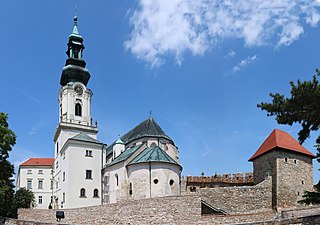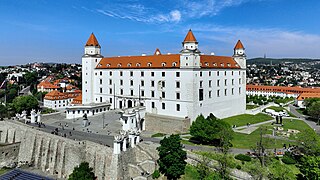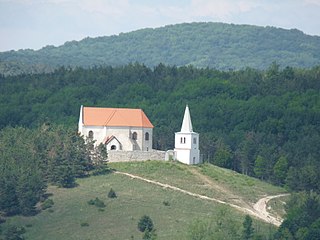
Znojmo is a town in the South Moravian Region of the Czech Republic. It has about 34,000 inhabitants. Znojmo is the historical and cultural centre of southwestern Moravia and the second most populated town in the South Moravian Region. The historic centre of Znojmo is well preserved and is protected by law as an urban monument reservation.

Great Moravia, or simply Moravia, was the first major state that was predominantly West Slavic to emerge in the area of Central Europe, possibly including territories which are today part of the Czech Republic, Slovakia, Hungary, Austria, Germany, Poland, Romania, Croatia, Serbia, Ukraine and Slovenia. The formations preceding it in these territories were Samo's tribal union and the Pannonian Avar state.

Nitra is a city in western Slovakia, situated at the foot of Zobor Mountain in the valley of the river Nitra. It is located 95 km east of Bratislava. With a population of about 78,353, it is the fifth largest city in Slovakia. Nitra is also one of the oldest cities in Slovakia; it was the political center of the Principality of Nitra. Today, it is a seat of a kraj, and an okres.

St Martin's Cathedral is a church in Bratislava, Slovakia, and the cathedral of the Archdiocese of Bratislava.

A rotunda is any roofed building with a circular ground plan, and sometimes covered by a dome. It may also refer to a round room within a building. The Pantheon in Rome is perhaps the most famous, and is the most influential rotunda. A band rotunda is a circular bandstand, usually with a dome.

Bratislava Castle is the main castle of Bratislava, the capital of Slovakia. The massive rectangular building with four corner towers stands on an isolated rocky hill of the Little Carpathians, directly above the Danube river, in the middle of Bratislava. Because of its size and location, it has been a dominant feature of the city for centuries.

Svätý Jur is a small historical town northeast of Bratislava, located in the Bratislava Region. The city is situated on the slopes of Little Carpathians mountains and surrounded by typical terraced vineyards with more than 700 years of winemaking tradition. In 1990, the intact city center was declared a protected city reservation. Cadastrially, Svätý Jur includes also the natural reserve Šúr, established in 1952 to protect one of the last and largest remnants of a tall-stem swamp alder forest in Central Europe.

Devín Castle is a castle in Devín, which is a borough of Bratislava, the capital of Slovakia.

Ducové is a municipality (village) situated in western Slovakia, near the spa town of Piešťany. It was part of the municipality Moravany nad Váhom from 1976 to 1992. The village lies under the Váh Inovec. According to the 2011 census, the municipality had 375 inhabitants. 365 of inhabitants were Slovaks and 10 others and unspecified.

Piešťany District is a district in the Trnava Region of western Slovakia, with the town of Piešťany being as its seat, cultural and economic center.
Tourism in Slovakia offers natural landscapes, mountains, caves, medieval castles and towns, folk architecture, spas and ski resorts.

Bojná is a municipality in the Topoľčany District of the Nitra Region, Slovakia. The village has a population of 2013 people. The main landmark is the Catholic Church of All Saints built in 1787. Opposite the church stands synagogue, later turned community center then car repair and nowadays a bar. The village stretches about 4 km along river Bojnianka which continues through villages of Veľké Dvorany, Urmince and Chrabrany before emptying into the Nitra river, itself a tributary of the Danube.
Boldog or Pozsonyboldogfa is a village and municipality in western Slovakia in Senec District in the Bratislava Region.

Kostoľany pod Tribečom is a village and municipality in Zlaté Moravce District of the Nitra Region, in western-central Slovakia.

Holíč is a town in western Slovakia.

Saint James's Chapel is a ruined gothic chapel and surviving ossuary discovered underneath Námeste SNP in the center of Bratislava, Slovakia, in 1994. It is the oldest sacral medieval structure and the only ossuary in Bratislava.

Church of Saint Margaret of Antioch, near Kopčany, Slovakia, is one of still standing churches for which the Greater Moravian origin is considered. It belongs to the oldest churches in Slovakia. The church was built probably in the 9th or 10th century and was first mentioned in 1329. It was used until the 18th century when a new church was built in the village of Kopčany.

The Basilica of the Assumption of Our Lady in Old Brno Abbey is a high Gothic, monumental convent temple. It was founded in 980-1020 by the unknown lord or monarch in Moravia. It was built on the site of an ancient sanctuary from the late 10th century in a short time in the years 1323 to 1334 at the instigation of Queen Elizabeth Richeza. It is the best preserved stylistically coherent and unified temple in Lands of Bohemian Crown.

The Basilica of St. James is a Gothic church in Levoča, Prešovský kraj, Slovakia. Building began in the 14th century. It is a Catholic parish church, dedicated to James the Apostle.
The architecture of Slovakia has a long, rich and diverse history. Besides Roman ruins, Slovakia hosts several Romanesque and Gothic castles and churches, most notably Spiš Castle, which were built at the time of the Kingdom of Hungary. Renaissance architecture was of particular relevance in town hall squares, such as in Bardejov and Levoča. Affluent architecture in the following centuries made use of Baroque, Rococo and historicist styles, while vernacular architecture in the countryside developed a specific style of wooden houses and wooden churches. In the 20th century, Slovakia knew Art Nouveau and modernist architecture, including socialist modernism, and finally contemporary architecture.


















